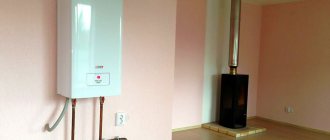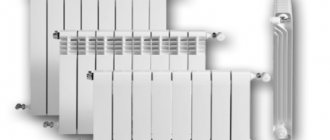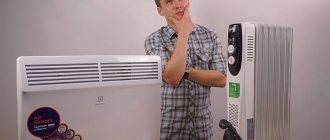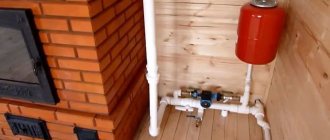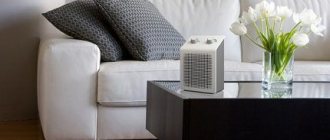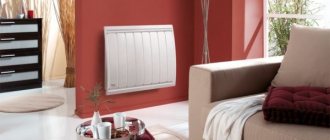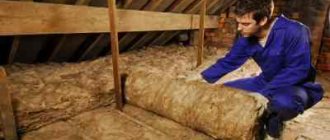The heating system of a private home is always a difficult task. Often the consumer is faced with the task of choosing what is better to use: an electric boiler or convectors? In this situation, it is necessary to analyze all the advantages and disadvantages, calculate the economic benefits, efficiency, and calculate possible nuances. There is no universal solution; the right choice is the most adapted option, which will take into account a number of nuances:
- regularity of home visits;
- area to be heated;
- duration of use of the premises;
- financial opportunities.
Description of electric convectors
Convector heaters are a modern development that combines thoughtful design, simple operation and installation, universal or exclusive design.
The operation of the convector is simple: in the lower part of the rectangular body of the device there are structural openings through which cold air enters the device. Under the influence of the heating element, air masses warm up and, according to the law of physics, rise, making room for cold air. In this way, natural movement, or convection, of air masses occurs.
Electric convectors (there are also water and gas) are completely ready for use and quite easy to operate. For the device to start working, it is enough to install it and connect it to the power supply. The advantages of these heating devices include:
- easy installation;
- easy to use;
- functionality;
- reliability;
- environmental friendliness and safety for the human body.
Environmental friendliness is ensured due to the relatively low temperatures of the heating elements. Unlike classic heating radiators, convectors do not burn oxygen or dust, and do not dry the air (more about the operating diagram - how an electric convector works).
Comparative table of the cost of organizing heating
| House area, m 2 | Heating method | Manufacturer and model | Total cost, rub. | Price of 1 kW of thermal power, rub. |
| 60 | Electric convectors | Ballu BEC/EZMR-2000 (3 pcs.) | 3 000*3 = 9 000 | 1 500 |
| Electric convectors | REDMOND SkyHeat C4519S (3 pcs.): el. control, connection and programming via app | 9 600*3 = 28 800 | 4 800 | |
| Electric boiler and radiators | Protherm Skat 6 KR 13 + Rifar Base 500 x6 (4 pcs.) + harness | 32 000 + 4 200*4 + 5 000 = 53 800 | 8 966,6 | |
| 100 | Electric convectors | Ballu BEC/EZMR-2000 (6 pcs.) | 3 000*6 = 18 000 | 1 800 |
| Electric boiler and radiators | Protherm Skat 12 KR 13 + Rifar Base 500 x6 (9 pcs.) + harness | 35 000 + 4 200*9 + 6 000 = 78 800 | 7 880 | |
| 150 | Electric convectors | Noirot CNX-4 1500 (10 pcs.) | 6 300*10 = 63 000 | 4 200 |
| Electric boiler and radiators | Vaillant eloBLOCK VE 18 Rifar Base 500 x6 (13 pcs.) | 39 000 + 4 200*13 + 9 000 = 102 600 | 6 840 |
As you can see from the table, the larger the area of the house, the higher the cost of each kW of thermal energy obtained when heating with convectors and the lower when heating with an electric boiler. At the same time, the advantages and efficiency of an electric boiler are obvious.
BoilersHeatersElectric boilers
Installation of an electric convector
Heating convector heaters are easy to install. The body of the device reaches low temperatures, which allows you to mount the device in any place without fear of spoiling the decorative finish or interior. Electric convectors are divided into types according to installation method:
- universal;
- wall;
- floor;
- built-in
Universal convector heaters are mounted on brackets to the wall or installed on the floor. The set includes legs or casters. The universal installation method allows you to change the location of the heating device. You can mount the convector yourself.
Wall-mounted models are installed similarly to universal ones, with the exception of the configuration, which does not provide additional legs for installation on the floor. But if the design allows, they can be purchased separately. You can mount the device next to decorative elements or on delicate decorative trim, but keep in mind that warm air moves vertically from the device. It is not recommended to place flowers, pet houses or any objects above it that may overheat or block the flow of warm air masses.
Built-in models of convector heaters are installed in a special niche in the floor at least 20 cm deep. The upper part of the heating device is covered with a grille. This type is stationary; the device cannot be moved. As a rule, built-in heaters are used for non-residential premises - exhibition halls or shopping centers, where the convector creates a thermal curtain. In private homes, such devices are used in cases where the walls are made entirely of glass. There are also models that can be built into a window sill.
Heating a house with convectors
Convector heaters are often used to heat a home. Such devices, in most cases, do not require installation. The devices are installed in rooms, corridors, loggias, connected to the electrical network.
Convector heater
The absence of special manipulations during installation is compensated by relatively high energy consumption, as well as complete dependence on it. By the way, there is some benefit here. In case of problems with the network, one medium-power gasoline (diesel) generator is enough to start at least one convector. This will be enough to keep the building warm and prevent the pipeline from freezing.
When the house needs additional heating, a convector will be a competent and rational solution. The heaters are compact, easy to install or move (for some types). The functionality of most devices allows you to regulate the power and intensity of heating.
Note! It is not recommended to save on the number of devices. Insufficient heating of concrete structures leads to the formation of excessive moisture and mold. Naturally, all this depends on the climate, but this problem is quite common for owners of this type of device.
The appearance of heating devices is rarely taken into account, but in the case of this type of heaters this point cannot be ignored. In the assortment of stores you can find a variety of universal models, stylish convectors in the middle price category. But you can create an individual order when the manufacturer applies an image to the panel or veneers it with natural stone. The last option is the most expensive, but is suitable for those who carefully calculate and plan the design of the premises.
Best answers
Boss Heat:
The store correctly said that the ceiling height is 3m. Electric convectors are the cheapest option in terms of equipment and installation costs. And you will pay for electricity from the money you save on equipment. You can increase savings and comfort by connecting one convector through a room thermostat via air. The cheapest electric convectors are Chinese or jointly produced, cheap does not mean bad
Pay attention to the configuration of the heating element in the convector, if it is tubular with a screw band around the tube (DELSOT) - at night you will hear it clicking when cooling or heating. If you take more expensive convectors - Siemens, Atlantic, Nobo, then they have a built-in air thermostat and they don’t click
Installing convectors under windows, do not block them with curtains, do not dry things on them, do not block the air flow from above, i.e., observe fire safety. Infrared heaters can be installed where there are no people and high ceilings. It is not comfortable to be under it. Pay special attention to the safety of electrical wiring.
Pavel Melnikov:
I heat it, it’s -30 outside the window, sometimes I open the window in one room, I overdid it, but I’m quite satisfied.
prickly hedgehog:
Can you imagine how much you will pay for electricity????
&Ъ:
In such frosts, a lot of energy will be burned. Four kilowatts without turning off, Ten kilowatts per day. It’s possible to heat if you spend the same money as on firewood on electricity. But, in my opinion, it will be more expensive. Fan heaters provide good heating.
Sergunok:
depending on the permitted power (input machine) and the general condition of the electrical wiring
Pie with kittens!:
haven't encountered... On the contrary, I’m thinking why I rented the air conditioning for the winter - in a room below +30 only with an open balcony!!!! -they're drowning!!!!
Alexandra:
When it’s cold outside and the heating isn’t turned on, I use a convector. It’s very convenient, you turn it on at 22 degrees and that temperature stays constant. My relatives heat a house in the village. 1.5 kW at 18m.
Fool number one and a half:
Infrared are demanding in terms of dimensions - ceiling height, distance from the ceiling and walls. If the ceilings are low, they will be reachable, and the temperature is high, someone taking off a sweater could get burned. It is inconvenient to use them for such housing. Better convectors. The calculation indicated is applicable.
Konstantin Lozhkin:
Infrared in the house as the main heating is insanity, a constant headache is guaranteed. Convectors are good because they are inexpensive, easy to install and quite reliable. Regarding the selection of power, of course, they were correct, but with a ceiling height of no more than 2.8 meters and good thermal insulation. In general, I installed a Nobo in my house and divided it into 2 groups. Each group has its own thermostat. It’s a bit expensive to heat purely with electricity, so when it’s cold I still turn on the stove.
Yuri Dubov:
Dmitriy! If you can survive the winter as usual, try to survive it, plan house insulation work in the spring and summer, look at the technologies for gluing with foam plastic, etc., there are a lot of interesting things there, but only then do the heating. These works do not require special qualifications, but only then deal with heating. I would recommend a combined heating system
Pay attention to “beril” electric boilers, but first of all, eliminate as much heat loss as possible, the costs will pay off
Artyom Shlentov:
For anyone who is interested, I suggest that you familiarize yourself with the table of electricity consumption for ceiling film electric heaters:
Natalia:
I have been heating myself for 4 winters with convectors “noirot” France, I heat 94 square meters, at - 10-20 degrees I pay per month 2300-2900 if -25-40 degrees I cry 3500-5000 the temperature is set to +22 in the whole house, “nobo” is also a great manufacturer, all other convectors except “noirot”, “nobo” are not intended for constant heating, the main thing is that the house is well insulated and the wiring is good, I have a separate automatic circuit breaker for each convector, start with one convector, count how much electricity it consumes and make a decision, the devices are very convenient, I turned it on in the fall and turned it off in the spring, convenient!!!
Pros and cons of convectors
So, what are the advantages of heaters of this type:
- no installation costs;
- possibility of installation only in necessary rooms (as well as switching off devices in closed or unused rooms)
- mobility (plus they take up little space);
- ease of use, accessible to everyone;
- convective heaters can be placed in any room, including bathrooms or electrical rooms;
- large selection of options and additional functions;
- safety, environmental friendliness;
- external aesthetics.
The disadvantages include the following:
- uneconomical;
- cost (in some cases).
What is ultimately more economical and efficient: electric boiler or convectors
As mentioned earlier, the choice depends on the area of the private house and the model of electric boiler/convectors.
For a house with an area of 40-80 m2, you can safely choose 2-4 convectors with a power of 2 kW each, the total cost of the solution will be about 5,500-10,000 rubles. + organization of separate wiring for their power supply, because It is simply unsafe to turn on devices of such power for a long time and is fraught with constant overloads.
The minimum costs for organizing heating will cover operating costs that are 5-20% higher for many years to come. With a larger budget, in order to increase efficiency and operating comfort, you can pay attention to the more expensive models Noirot, Electrolux, Ballu or Nobo.
For houses with an area of 80-120 m2, the choice is still not obvious, since the total cost of convectors is already closer to the cost of organizing a heating system with an electric boiler and radiators, and the advantages of good electric boilers are already obvious.
For houses with an area of 120-300 m2 or more, it is better to use an electric boiler. The heating system will be more stable, the savings due to control through an external room thermostat will be extremely noticeable, the connection of a powerful electrical appliance will be carried out at one point, you can easily solve the issue of hot water supply, connect heated floors, rationally use the buffer tank.
How to accurately calculate the required boiler power Individual calculation, formula and correction factors
What is an electric boiler
An electric boiler is a heating device; its operating principle is to convert electrical energy into heat. The heating element acts on the flowing coolant circulating through the pipes of the heating system. Simply put, the heaters come into contact with water (or other chemical liquid) that moves through the pipeline, heating it. Radiators, in turn, warm the air.
Electric boilers are distinguished according to several criteria. By type of installation, devices are divided into:
- wall;
- floor
By type of heating elements:
- shadow;
- electrode;
- induction
Induction electric boiler
Models also differ in power (energy consumption) and functionality. The most affordable and simple boilers contain a heater and starting equipment, medium-functional ones are equipped with temperature control and monitoring units, and the most “top-end” ones are controlled remotely.
Note! Models with shades can have a dual-circuit system, which will provide the house not only with heat, but also with hot water.
The coolant is distilled or salt water, and antifreeze can be poured into induction boilers. In both cases, the cost of the liquid is quite low.
Principles of constructing a heating system using convectors and electric boilers
The decision about which heating method to choose is made based on basic criteria:
- the cost of the electric boiler or convector itself, estimates for refurbishment or initial installation of the heating system in the house/apartment;
- expected level of comfort and savings on electricity bills;
- the ability to use old infrastructure in the house - wiring, pipes, heating radiators.
The principles of planning a heating system using convectors and electric boilers are in many ways similar, there are only features associated with balancing the load across different rooms.
Features of installation of an in-floor convector
Description of heating elements of electric boilers
It is worth taking a closer look at the types of heaters used in electric boilers. Some values can significantly affect the choice of the appropriate model.
Tubular heaters are used in various devices: dishwashers and washing machines, convectors, as well as in electric heating boilers. The elements are completely immersed in the coolant and transfer heat to them. Among the advantages are the low cost and simple replacement of tens that have failed.
There are also some disadvantages of such heaters, for example, if the element is not completely immersed in the coolant, it quickly burns out. Scale forms on the heating elements, which somewhat slows down the heat exchange.
The induction type is quite expensive (both the equipment itself and its components), but this is compensated by the increased efficiency of the device. Heating is carried out due to the influence of a magnetic field (similar to induction electric stoves) on the coolant.
The design is very durable, the internal mechanisms do not wear out, with the exception of the control unit. If you plan to use the heating device for a long time, for example, permanent residence in a country house, then this type of system will be optimal.
Electrode boilers are particular about the composition of the coolant; the water should not be distilled, but contain salt. Moreover, the content rate is calculated after measuring the current. Here you will have to carefully study the instructions and determine the optimal composition of the water.
Features of using an electric boiler
The average power of an electric boiler is selected at the rate of 100 W/h for each square of housing area plus 10% reserve. For heating systems based on electrode and heating element models of electric boilers, it is recommended to increase the reservation to 15%; for induction models of electric boilers, the reservation need not be made.
While special coolants based on ethylene glycol are widely used in gas boilers, they are not used for electric boilers. In electrode and induction models they are useless; in designs with heating elements, such a coolant degrades, decomposition products clog heating radiators and are deposited on tubular heating elements.
Experts recommend pouring distilled water with additives into the heating circuit and changing it before the start of the season.
The second requirement relates to the use of a boiler; a 200 liter insulated barrel will help save on electricity, especially if the house has a meter with a night tariff. During the day, the temperature in the rooms can be maintained by a heat accumulator, and in the evening you can start an electric boiler in the heating system.
The third requirement relates to proper load balancing. To coordinate hydraulic resistance and heat transfer, the heating pipes are divided into two parallel circuits. The first includes a living room and bedroom, the second - a kitchen, bathroom and toilet. The output from the circulation pump of the electric boiler is fed to a tee, from which the pipes diverge into two circuits. You just need to adjust the water flow through each heating line using a tap. If the house has two or three floors, then it is best to install several low-power electric boilers for each heating tier.
Principle of installation of convectors
Installing electric convectors in a house is easier than installing boilers. First, you need to determine where to install the convector in each room. For living quarters and kitchens, you can use models with protection level IP21, for bathrooms and toilets - IP24.
Secondly, for each convector you will need to lay your own cable with ground. We put the wiring in a heat-resistant channel and cover it with a plinth. In addition, each convector must have its own socket for a Euro plug with ground and a bag. The wire cross-section is selected according to the permissible constant load.
We collect all the wiring on a distribution panel with circuit breakers for each branch. Here you can install a programmable automatic machine that controls the operation of the convectors.
Boiler installation
Compared to a convector, an electric boiler is much more difficult to install. If convector heaters are completely ready for use after purchase, then the electric boiler will require assembly and installation of a pipeline. Moreover, you should first analyze and plan where it will take place, in which rooms it needs to be placed. Of course, this will require additional costs and time, therefore, for heating with electric boilers, preparations must begin in advance.
Despite the complexity of installation, it cannot be said that it is better to use a conventional convector (or similar heaters) instead of an electric boiler. The piping system heats the air over its entire surface, and convectors provide local heating. Speaking about the pipeline itself, aluminum elements can be used as radiators.
Border Rule 4 and 6
In order to decide what is the best way to heat a house, it will be very important to know the size of the house, or more precisely, the number of heating devices needed around the entire perimeter of the house. Experts were able to establish fairly clear boundaries. If the house is very small and only needs 4 heating devices, then there is no point in installing an electric boiler and radiator network. In such a house it will be much easier and simpler to install electric convectors. If the house is large enough and already needs 6 heating devices, then experts definitely recommend purchasing an electric boiler. A rather complicated situation arises if 5 heating devices are enough for your home. Indeed, in this case, you can choose both options for yourself.

